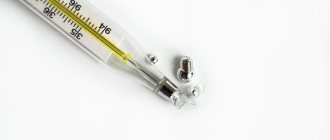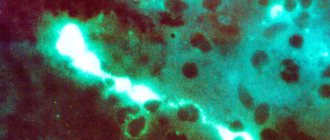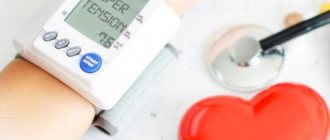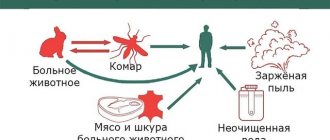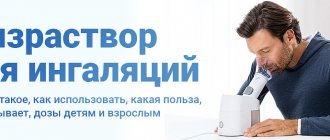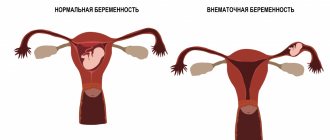Tachycardia is the medical name for rapid heartbeat when the heart rate exceeds 90 beats per minute and can even reach 150-220.
Everyone experienced interruptions in the functioning of the heart in the form of rapid heartbeat and lack of air. This happens in healthy people during severe anxiety, fear and other emotional shocks. This is a normal response of the cardiovascular system to stress. But such symptoms do not always have physiological causes. During physical activity, the heart begins to beat faster in all people, and everyone knows that this is how it should be. But if there is not enough air during the heartbeat, and this repeats periodically even with minor exertion, you need to be examined. In such cases, the cause is most likely a disease.
There are pathological and physiological tachycardia. In the first case, rapid heartbeat is a sign of a disease; it can appear at rest; in the second, it is a natural phenomenon that accompanies emotional and physical stress.
In addition, it comes in two types:
- Sinus. Cardiac impulses are generated in the right atrium in the sinus node - the physiological pacemaker. Characterized by an accelerated sinus (normal) rhythm. The cardiogram shows that the time of systole (contraction of the heart muscle) and the time of diastole (resting state) are significantly shortened, the rhythm remains regular.
- Paroxysmal. It is characterized by paroxysms - attacks of palpitations with a heart rate from 140 to 220 beats per minute. They begin suddenly and end unexpectedly, vary in duration, but maintain a regular rhythm. Impulses are generated outside the sinus node and are called ectopic. Their source may be the ventricles, atria, or atrioventricular junction. Ectopic rhythms can occur as replacement rhythms when the activity of the sinus node ceases or weakens. This occurs during ischemic, sclerotic, inflammatory processes in the sinus node and other parts of the conduction system, with autonomic disorders, and an overdose of cardiac glycosides.
Physiological tachycardia
Rapid heartbeat is a normal reaction of the cardiovascular system to certain stresses. Physiological tachycardia is always sinus. The main reasons for its occurrence:
- Exercise stress.
- Fear, excitement.
Under such loads, the heart begins to beat faster, but the pace normalizes when the load stops. Heart rate increases gradually and decreases smoothly. Palpitations in these cases do not have any negative impact on health, and no treatment is required. In case of stress, fear, anxiety, you can help the body recover with the help of sedatives.
When you exercise, your heart rate always increases. This is how the heart provides the muscles with an increased need for oxygen.
Main symptoms
Tachycardia manifests itself in different ways; clinical symptoms depend on age and concomitant diseases. Rapid heartbeat may be accompanied by a feeling of discomfort in the chest, a drop in blood pressure, and weakness. There may be a feeling of shortness of breath, dizziness, darkening of the eyes, fainting. A patient with angina pectoris experiences chest pain as a result of an imbalance between the heart's increased oxygen demand and decreased O2 delivery. In people with heart disease, an attack of tachycardia is accompanied by a sharp increase in shortness of breath.
Features of the floors
There are no particular differences between the manifestations of tachycardia in men and women, except for autonomic reactions and emotional overtones.
The heart beats and bubbles in the throat, gives rise to fever, severe sweating, trembling in the body - this is how the signs of tachycardia in women are vividly described. They are more likely than men to have chronic non-paroxysmal sinus tachycardia - a disease when heart rate does not correspond to the level of physical activity or emotional stress. A possible mechanism for its development is considered to be an anomaly of the sinus node or increased automaticity of the heart.
Postural orthostatic tachycardia is also predominantly characteristic of women. It is accompanied by an inadequate increase in heart rate when the body position changes from horizontal to vertical.
Pathological tachycardia
Usually occurs suddenly. Its causes are diseases and pathological conditions, including:
- Cardiovascular disorders and diseases of the circulatory system (myocarditis, hypertension, heart defects, anemia, myocardial infarction, cardiosclerosis and others).
- Disturbances in the functioning of the autonomic nervous system.
- Endocrine pathologies associated with impaired hormone production (diabetes mellitus, thyrotoxicosis, pathological menopause and others).
- Neuroses, severe stress.
- Bleeding, blood flow disorders.
- Some infections and inflammations (acute and chronic).
- Disturbances in the electrolyte balance of the blood due to a deficiency of elements that ensure the functioning of the heart muscle (magnesium, potassium).
- Malignant tumors.
- Alcoholism, smoking.
- Constant lack of sleep, stress and fatigue.
First aid for a heart attack
Actions consist of calling a doctor and providing assistance before his arrival. It is recommended to do the following:
- if possible, lay the patient down so that he is comfortable and can breathe deeply and evenly;
- open the windows, unbutton the collar, loosen the tie and remove other items of clothing that impede deep breathing;
- wash your face with cool water.
To eliminate palpitations, sedatives (valerian, corvalol, valocordin) are often used. If you don't have them at hand, you can do the following:
- Tighten the muscles of your legs and abdomen for 10-15 seconds, then relax. Repeat after two minutes.
- Take a deep breath, hold your breath for a few seconds, exhale slowly.
- Massage the tips of the little fingers on your hands.
During pregnancy
During this period, women often experience increased heart rate. Usually the heart rate exceeds the norm by 20-25 units. This is due to weight gain, changes in hormonal balance and metabolism, and magnesium and iron deficiency. In addition to rapid heartbeat, the woman complains of dizziness, lack of air, and chest pain.
If your blood pressure is normal, a pregnant woman does not need to take any medications. Doctors advise the expectant mother not to worry, to walk more often, eat more fruits, do gymnastics and breathing exercises. For high blood pressure, headaches and shortness of breath, tablets may be prescribed.
Despite the fact that tachycardia is allowed during pregnancy, the heart rate must be monitored
Clinical case
In my practice, there was a case of sinus tachycardia in a pregnant woman.
The woman constantly felt a rapid heartbeat, which was an adaptive reaction of the body: pressure decreased, heart rate increased; but the patient was also diagnosed with anemia. After correcting the hemoglobin level with iron supplements, her health improved and the feeling of palpitations disappeared. Although at first the woman was sincerely surprised when she was not prescribed drugs to slow down her pulse! Depending on the location of the source of excitation, tachycardias are divided into supraventricular and ventricular.
The first arise in the structures of the heart up to the level of branching of the trunk of the His bundle: in the atria, AV node, in additional conduction pathways. The source of origin of the latter is the His bundle, Purkinje fibers, and ventricular myocardium.
Based on the nature of the course, paroxysmal and non-paroxysmal types of pathology are distinguished.
According to the mechanism of occurrence - reciprocal, ectopic, with trigger activity, and so on.
Differential diagnosis of arrhythmias is a difficult and responsible task. In particular, when it comes to tachycardia with wide QRS complexes on the ECG. This may be a ventricular arrhythmia or tachycardia involving the accessory tract (accessory tract).
Ventricular tachycardia has a poor prognosis and occurs as a result of damage to the heart muscle. In contrast, arrhythmia involving the AP appears in a person without gross structural pathology of the heart.
To clarify the type of tachycardia, an ECG with an intrathoracic lead should be recorded or a transesophageal electrophysiological study should be performed. However, in real clinical practice, such an opportunity is rarely provided, and in these situations the doctor is guided by the following rule: assess the condition as the most dangerous to human health and life and begin appropriate treatment.
In children
Heart rate norms in children are higher than in adults. In newborns it can reach 160 beats/min, in one-year-old babies - 130-140, by the age of seven - 80-100. Changes occur quickly in a child’s body, and the heart adapts to new conditions, so it is not always possible to accurately determine the causes of tachycardia.
A fast heartbeat in a child can be dangerous and lead to heart disease in the future. It is important that the child leads a healthy lifestyle.
The causes of pathological tachycardia in children are the same as in adults. They are diagnosed with sinus, paroxysmal and chronic tachycardia. Paroxysmal is dangerous, in which the heart rate increases two to three times. The child develops shortness of breath, bluish skin, veins begin to pulsate, and he may become very frightened. During an attack, you need air flow and rest. It is usually relieved by intravenous injections of glycosides.
Rapid heartbeat after eating
An increase in heart rate can occur both during a meal and immediately after a meal (half an hour later). In medicine, this phenomenon is called gastrocardial syndrome. In addition to tachycardia, nausea, dizziness, chest pain, cold sweat, and fear may occur. Digestion is a very energy-consuming process, so the heart begins to work faster. Frequent heartbeats that occur during and after eating may be an individual characteristic of a person. In this case, doctors recommend following the following rules:
- eat more often in small portions;
- exclude or limit unhealthy foods (spicy, fried, fatty, smoked, fast food, soda, sugar-containing foods);
- reduce the amount of meat in the diet;
- do not drink water after meals;
- Do not exercise immediately after eating.
After drinking alcohol
Heart palpitations after drinking alcohol are common. In this case, the heart always starts beating faster, and this is a normal reaction of the body. Such tachycardia is considered physiological if alcohol is taken occasionally. In chronic alcoholism, pathological tachycardia develops. An experienced alcoholic has impaired heart function, and most often it is no longer possible to restore it even after giving up the addiction.
After drinking alcohol, physiological tachycardia develops, but with alcohol abuse it becomes pathological.
How to choose a cardiologist
If you want to go to a medical institution for consultation because of rapid heartbeat, then first of all it is important to choose a clinic that has proven itself well. Advantages of the EXPERT Clinic:
- multidisciplinary medical center, which allows you to get advice from various specialists if necessary
- experienced and attentive cardiologists
- modern examination equipment, as well as practicing specialists in ultrasound and functional diagnostics
- the ability to quickly take all tests and provide examination results
- the most attentive attitude towards patients, only an individual approach, a detailed study of the problem
- convenience and comfort in the clinic, responsive medical staff.
Do not delay visiting a cardiologist, because timely identification of the main problem of “rapid heartbeat” can sometimes save your life.
Tachycardia and blood pressure
With low blood pressure
Tachycardia with low blood pressure is a common occurrence. This combination is typical for vegetative-vascular dystonia, in which, in addition to a rapid pulse, there is pallor of the mucous membranes and skin, nausea and dizziness, headache, feelings of anxiety and fear.
Low blood pressure and high pulse are observed during bleeding and shock conditions (anaphylactic, traumatic).
With normal blood pressure
If the pulse is increased at normal pressure, the reasons may be the following:
- Endocrine diseases (hyperthyroidism).
- Vegetovascular dystonia.
- Cardiac pathologies (arrhythmias, myocarditis, pericarditis, heart defects and others).
- Intoxication due to infections.
- High temperature with inflammation.
- Anemia.
- Increased adrenaline levels in the blood.
- Purulent-septic processes.
- Pulmonary pathologies (pneumonia, asthma, obstructive pulmonary disease).
- Malignant tumors.
With high blood pressure
Tachycardia with elevated blood pressure is observed in neurocirculatory dystonia of the hypertensive type.
A rapid pulse can be caused by the same reasons as hypertension. To normalize your heart rate, you need to lower your blood pressure.
Diagnostics: when and with what to see a doctor?
Any first-time attack of tachycardia that negatively affects your well-being is a reason to consult a doctor! And the more pronounced the clinical manifestations, the sooner you need to consult. If a person loses consciousness during a paroxysm, it is necessary to immediately call an ambulance and perform electrical cardioversion (impact of a pulsed current discharge on the heart).
Doctor's advice: check-up list for suspected tachycardia
To establish a correct diagnosis, the following studies and tests are necessary:
- electrocardiogram - at rest and at the time of rapid heartbeat;
- Ultrasound of the heart - data on the structural structure and valve apparatus;
- daily ECG monitoring;
- transesophageal EPI (TEPE);
- general blood test - will provide information about the presence of anemia and/or inflammation;
- blood test for thyroid hormones and TSH;
- consultation with an ENT doctor (if you have a history of frequent sore throats) and a dentist (caries) to identify and treat foci of chronic infection.
This is the minimum research that will help establish the cause of tachycardia, its nature and type, or allow you to choose a further diagnostic direction. Often, the doctor needs to seek help from fellow arrhythmologists who are able, using modern instrumental methods, to determine the area with pathological impulses. After its localization becomes known, the issue of minimally invasive destruction of the lesion can be decided.
If rapid heartbeat is the result of chronic tonsillitis, then by eliminating the cause (by performing surgical removal of the tonsils), you can forget about the heart problem. Such patients complain of pain in the heart area. Why chest discomfort occurs with a sore throat and how to act correctly - read here.
If the study reveals changes in thyroid hormone levels, or pheochromocytoma is suspected, then an endocrinologist will treat such a patient. It is worth noting that in clinical practice the first symptom of thyrotoxicosis is paroxysm of atrial fibrillation. Therefore, all patients with new-onset atrial fibrillation need to determine the concentration of thyroid hormones in the blood.
Monitoring a person with tachycardia first of all involves monitoring by a specialist who treats the underlying disease. It is a competent approach to the pathology that causes arrhythmia that will help get rid of unpleasant symptoms and minimize the consumption of medications.

